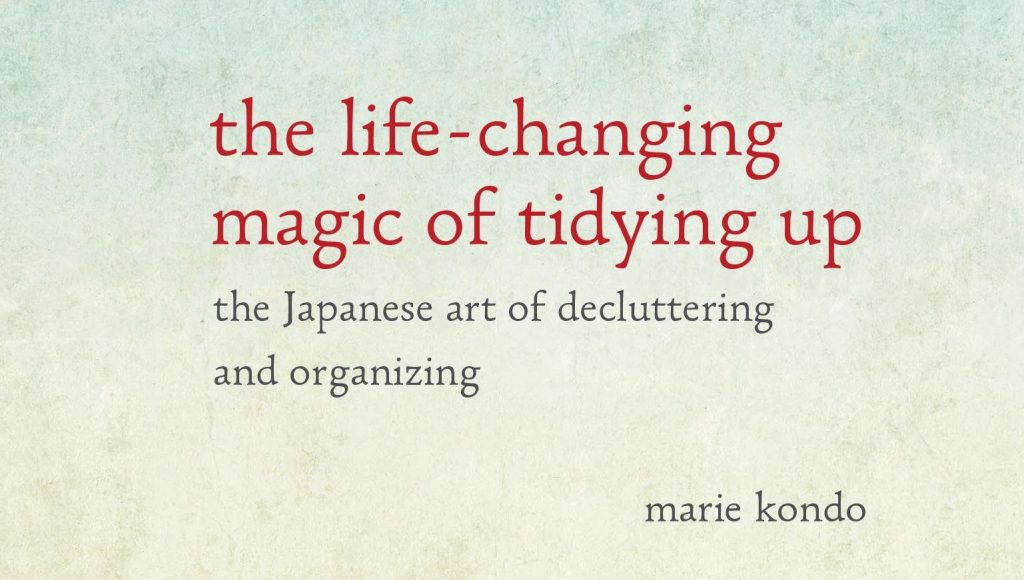The Life Changing Magic of Tidying Up Your Writing

When the Life Changing Magic of Tidying Up by Marie Kondo became an international bestseller, I was initially skeptical and slightly overwhelmed by the popularity. From lifestyle gurus inundating the blogosphere with posts about how to fold your t-shirts into tiny little squares to the disgruntled packrats of the world letting their resistance be known in a litany of follow-up think pieces, Kondo was everywhere.
At a certain point I gave in and just wanted to know what all the fuss was about. I’m neither a tidy person nor am I very interested in self-help books, but something about Marie Kondo’s simple, playful and slightly mystical method of organizing pulled me in, so I put her KonMari method to the test.
Flash forward a few years. I caught wind that Marie Kondo would be in Chicago as part of the Chicago Humanities Festival. I had felt the positive effects of her method on my home life and I was excited for what new wisdom she could bestow upon me. As I sat in the auditorium at the Harris Theater listening to her recount her steps to a tidy home, I realized that her method isn’t just about organizing stuff. It’s about about achieving the end result you want by removing the extraneous details that don’t add to your goals. In other words, it’s editing.
Listening to Kondo speak, I began to wonder how I could “tidy up” my writing. I’m no stranger to editing, but her unique philosophy put a different perspective on the process. So, how do you KonMari your writing?
1. Visualize the Destination & Identify Why You Want it
The first and second steps in the Konmari method are easily combined when applied to writing. Visualizing the life you want and identifying why you want it and are used as motivation throughout the process of decluttering and discarding. It’s a pretty direct correlation to writing—where do the words need to take the reader? What is the final message you want to get across or action you want the reader to take? Is it a print ad or web content of some kind? What goal are you accomplishing with this project?
For any creative pursuit, it’s unlikely you haven’t thought about your destination at all. You wouldn’t be wearing the copywriter hat if you didn’t have at least some idea of what you or your client wanted to say. But as the creative process goes on, sometimes we bob and weave before we reach the end.
Pro Tip: Keep the final goal in mind and it will help your writing—and make the editing steps a tiny bit easier.
2. Tidy All At Once
Contrary to most other organizing and tidying guides, the KonMari method recommends doing your big tidy all at once. According to Kondo, doing your discarding phase this way forces you to really take stock of every single thing in your home and be honest about your belongings. In writing, it can be tempting to try and edit as you go. I find myself in the bad habit of self-editing before words even get onto the page. I think I’m being efficient by eliminating stupid ideas before they take up space, but in fact some of those seemingly dumb thoughts might be where the colorful ideas come from.
Pro Tip: KonMari how you tidy your writing by making a pointed effort to fight the self-editing devil on your shoulder. Wait until you’ve gotten all your ideas on the page before slicing and dicing with the proverbial red pen.

3. Does it Spark Joy?
Here’s the big one that everyone loves to make fun of. The KonMari method hinges on this idea of taking each object, holding it in your hands and feeling your emotional reaction. If you feel an uplifting, positive reaction, you keep it. If you don’t, you let it go. Simple as that. A lot of people took issue with her method, pointing out that although their cutting board and vacuum cleaner don’t give them a noticeable sense of joy, they need to keep them around. But as Marie explained at her talk, if an object serves a function in your life and you use it to achieve your goals, it should bring you a sense of joy. It’s about reframing your perspective to appreciate the items that keep your home clean or help you prepare food for your family. You might not want to cuddle your tupperware, but it serves a purpose in your life that should be appreciated and that in itself is a kind of joy.
I can’t peel each word off my screen and individually hold them in my hands to search for a feeling of joy, but I can print the page out and really evaluate how each word and turn of phrase makes me feel. Rather than just sparking joy, I can ask myself: Does this say what I set out to say? Does it fit with the brand? Does it serve a purpose?
Pro Tip: Rather than viewing an assignment as joyless or “purely functional,” remember that it serves the needs of the client’s business. This is one of the main tenets of the BatesMeron manifesto and it’s why we do what we do as copywriters. This alone should bring you joy. If it doesn’t, it might not be the assignment. It could just be that you haven’t gotten it where it needs to be yet.

From sock drawers to copywriting, the KonMari method is a helpful tool or organize, declutter and pare down to the essentials. Give it a shot, and let us know what sparks joy for you!
Chinese New Year
Why Editors Matter
The Wonderful World of Words










